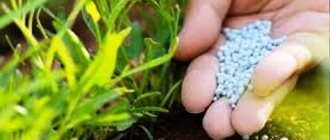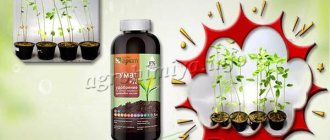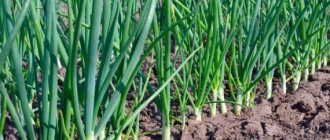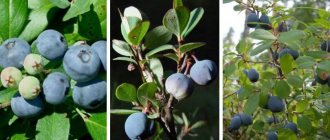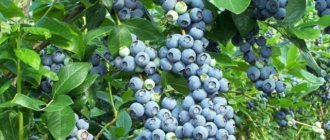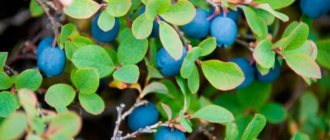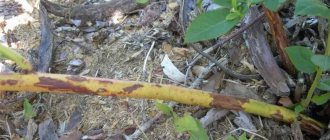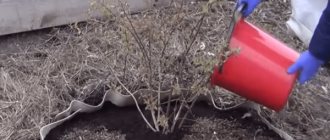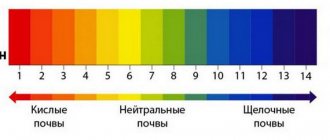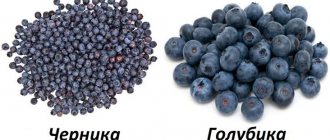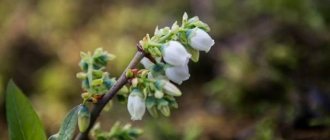Features of growing blueberries: what fertilizing is required
The main distinguishing feature of growing blueberries in the garden is the need for an acidic environment (3.5-5 pH). Therefore, blueberries are planted in an acidic peat mixture (based on marsh red or high peat, 50-60%), mixed with pine litter (rotted pine needles, 30-40%) and sand (10%).
If you plant blueberries in ordinary garden soil with a neutral reaction, or even more so in alkaline soil, then you can’t even dream of any significant yields. The shrub will develop poorly and stand stunted.
However, simply planting blueberries in acidic soil and using conventional fertilizers is not enough; over time, you will in any case need to maintain the acidity at the required level (since it will decrease), namely, feed the blueberries with acidic fertilizers or use special acidifiers (not fertilizers! ).
Interesting! The fact is that on the roots of blueberries in a close symbiosis (symbiotic relationship) lives a specific fungus - ericoid mycorrhiza, which helps the plant absorb nutrients from the soil, and it lives only at low acidity. In other words, it is not the blueberry itself that needs an acidic environment, but the mycorrhiza, which is located on the roots of the blueberry.
However, often novice gardeners focus exclusively on creating an acidic environment, without paying due attention to fertilizing with basic macro- and microelements, but blueberries, like other cultivated plants, need nitrogen, phosphorus, potassium, magnesium, sulfur and other nutrients.
Advice! Be sure to purchase special instruments to measure soil acidity.
Video: how to water and fertilize blueberries
Common mistakes when feeding blueberries
Gardeners who are not familiar with the peculiarities of the culture often make the following mistakes:
- If deadlines are not met, nutritional needs change during the growing season. The application of nitrogen in the second half of the season is fraught with the death of the crop.
- They violate the dosage - wanting to better feed the blueberries, gardeners apply too much fertilizer. This approach is no less destructive than completely ignoring the procedure. An excess of one substance suppresses the effect of others, provokes failure of vegetative processes, and tissue death.
- They use inappropriate compounds: preparations containing chlorine and nitrates that alkalize the soil have a detrimental effect on blueberries.
Blueberries are quite difficult to grow in your garden. Proper feeding significantly increases the chances of success. To get a rich harvest, it is important to stick to the schedule and avoid overfeeding.
When to feed blueberries in spring, summer and autumn: optimal timing and scheme
Many experienced gardeners adhere to this scheme for feeding blueberries in spring, summer and autumn:
Naturally, the composition of fertilizers differs from the time of year and the phase in which the plant is located.
- The first feeding of blueberries is done immediately after waking up (after the snow has melted) and swelling of the buds, in other words, during the period of active growth of the vegetative mass. It (feeding) should consist mainly of nitrogen fertilizers (ideally ammonium sulfate). But you can also take a complex mineral fertilizer, which contains equal amounts of all macroelements, such as nitroammophosphate (16% nitrogen, phosphorus and potassium each).
- The second feeding is carried out after flowering (at the beginning of the formation of ovaries and ripening of berries). Its goal is to increase the quality and sugar content of the fruit, which means it is necessary to fertilize blueberries with potassium fertilizers (+ microelements, especially magnesium).
- The last (autumn) feeding of blueberries is done after fruiting and berry picking, i.e. in the fall. The purpose of this autumn feeding is to help the shrub lay new flower buds for next year, as well as prepare the plant for winter (strengthen the immune system and improve its winter hardiness). This means that it must be a phosphorus -potassium fertilizer (the same superphosphate + potassium sulfate).
Important! Throughout the growing season, you need to control the acidity of the soil (it is optimal to keep it in the region of 3.5-5 pH) and, if necessary, be sure to acidify with special solutions (read about which in a separate paragraph “How to acidify the soil under blueberries”)
How to feed blueberries correctly
Basic recommendations and rules for effectively fertilizing blueberries in the garden:
- Before applying fertilizer, you should make a small (very shallow) groove around the trunk circle of the bush (stepping back 15-20 cm from it , where you need to apply fertilizer in liquid form or scatter dry granules over the surface of the soil, followed by embedding the fertilizer by loosening. Then water generously.
After applying the fertilizer, you can lightly sprinkle the furrows with acidic high-moor peat or other suitable acidic mulch (pine litter).
- Before feeding blueberries, it is recommended to first water the bushes with plain water , because... It is necessary to fertilize precisely on moist soil, especially with mineral fertilizers.
By the way! If there has been good rain recently and the soil is sufficiently moist, then there is no need to additionally moisten (water).
Advice! In general, it is advisable to shed the soil at least a couple of days before, or even better, the day before fertilizing.
- Feeding should be done in the morning or evening, or during the day in cloudy weather.
- As a rule, root feeding is carried out in the spring (in liquid form, but it can also be done in dry form). And in the summer , during the fruiting period, you can also perform foliar feeding (on the leaves).
Note! It is believed that foliar feeding is most effective when the plant especially needs certain microelements (which is manifested in its appearance). For example, in the case of chlorosis.
Worth knowing! Foliar feeding cannot completely replace root feeding.
- As for dosages (dilution proportions) and timing of use of certain fertilizers, always rely on the instructions on the packages and do not rely on memory.
Blueberry processing
In addition to root feeding, treating the bush with special nutrients can improve the condition of blueberries, their fruiting, and accelerate the growth and development of berries. At the beginning of spring, it is allowed to spray the plant with a weakly concentrated nitrogen solution, which will make it possible to stimulate the growth of green mass.
Don’t forget about treating blueberries for parasites and fungal diseases. To protect the crop, it is recommended to carry out professional spraying with special fungicidal (“ Kuprozan ”, “ Topsin M ”) and insecticidal (“ Aktara ”, “ Aktellik ”) preparations twice a season, in spring and autumn. It is important to consider that failure to comply with the required dosages can provoke the development of various diseases.
Several times a season, you can treat the bushes with a solution of succinic acid, which will protect the bush from pests and diseases, and also saturate it with nutritional components.
So, although blueberries are not very demanding in care, when growing they require high-quality, timely, and, most importantly, dosed feeding. Organic products are absolutely not suitable for feeding the crop, but the plant responds well to mineral preparations with abundant fruiting and high quality berries.
How to feed blueberries in spring, summer and autumn: fertilizer options
There are many effective ways to feed blueberries. Some are more expensive, others less, in any case, the choice is yours.
Let's get to the point, namely, we will consider in detail and list the main fertilizers suitable for feeding blueberries in spring and summer, as well as in the fall (after fruiting and picking berries).
Note! Blueberries are an “acid-loving” plant, which means that in alkaline soil they will absorb any nutrition very poorly.
Therefore, under no circumstances should blueberries be fed with wood ash or other deoxidizers that alkalize (lower acidity) the soil.
Also, you cannot use chlorine-containing fertilizers (i.e., chlorine-free ones are needed) .
Next, we will take a closer look at what fertilizers can be used, as well as how to combine them.
Nitrogen fertilizers
Used only in spring and early summer .
Mineral:
Note! The best nitrogen mineral fertilizer is ammonium sulfate , because contains not only nitrogen, but is also an excellent soil acidifier (contains sulfur).
- Urea (Urea) - 46% nitrogen (20-30 grams per 10 liters of water or per 1 sq.m);
- Ammonium nitrate - 33% nitrogen (30-40 grams per 10 liters of water or per 1 sq.m.).
Organic nitrogen fertilizers:
Note! Blueberries don't like any organic matter! Another thing is pine litter (necessarily rotted) or softwood sawdust.
Complex mineral nitrogen-phosphorus-potassium supplement
It is very convenient to use complex mineral fertilizers, which contain all macroelements.
So, blueberries in the spring (before flowering) can be fed with the following fertilizers:
- Nitroammophoska (nitrogen, phosphorus, potassium - 16% each). Prepare the solution at the rate of 20-30 grams per 10 liters of water.
- Diammofoska - 10% nitrogen, 26% phosphorus and potassium each (20-30 grams per 10 liters of water).
Note! These fertilizers do not contain any microelements, and it is highly advisable to add them. Therefore, it is highly recommended to add humates to solutions, for example, the same potassium humate .
Or complex ready-made cocktails with microelements such as Humate +7 Iodine.
- Plantofid or Plantofol (20:20:20).
Potassium-phosphorus fertilizers
Suitable for feeding after flowering and at the beginning of fruiting, as well as in autumn.
- Potassium sulfate (potassium sulfate) - 46-52% potassium (20-30 grams).
By the way! Instead of potassium sulfate (potassium sulfate), you can use potassium nitrate (Nitrogen -13.6, Potassium 46%).
It is also very convenient to use potassium magnesium , which, in addition to potassium, includes such an important trace element as magnesium.
Interesting! Magnesium, which promotes the process of photosynthesis, ensures bright and green foliage and prevents aging.
Note! Under no circumstances should blueberries be fed with wood ash (using it as a potassium supplement) or other deoxidizers that alkalize (lower acidity) the soil.
Quickly digestible phosphorus and phosphorus-potassium fertilizer
Suitable for feeding before and after flowering (during fruiting).
To make an easily digestible infusion of superphosphate for spring feeding of blueberries, you need:
Take potassium monophosphate , dissolve in water and fertilize. However, it cannot always be found in the store, and it is quite expensive.
Or:
- 1 kg of double superphosphate into 5 liters of boiling water;
- after the water has cooled, add 0.5 liters of 9% vinegar;
Acidifying the water will convert the calcium phosphate into a more soluble form.
- Let sit for 12-24 hours, shaking and stirring occasionally.
- Add another 5 liters of water, bringing the total volume to 10 liters.
- Then dilute 1 liter of the resulting superphosphate infusion with 10 liters of water (1 to 10).
- Feed.
By the way! You can also purchase a water-soluble fertilizer such as Plantafol or Plantafide (5:15:45) .
Autumn potassium-phosphorus fertilizing (after harvest)
The following combinations of mineral fertilizers can be an excellent option for feeding blueberries after fruiting and harvesting (i.e. in the fall).
First option:
- Superphosphate - nitrogen 6-9%, phosphorus - 26-30% (30-40 grams per 10 liters of water or per 1 sq.m.).
By the way! The site has separate material on how to use superphosphate .
- Potassium sulfate (potassium sulfate) - 46-52% potassium (20-30 grams per 10 liters or 1 sq.m.).
Second option:
- Diammofoska - 10% nitrogen, 26% phosphorus and potassium each (20-30 grams per 10 liters or 1 sq.m.).
Third option:
- Potassium monophosphate (Phosphorus - 50%, potassium - 33%) - 20-30 grams per 10 l or 1 sq.m;
Think! There is an opinion that blueberries can do without mineral fertilizers, because... This is primarily a forest plant, and they are more destructive for it than useful.
You can learn more about this by watching the following video:
Video: how to choose fertilizers for blueberries
Types of fertilizers
To understand what fertilizers to use to feed blueberries, you need to know how a particular element affects the condition of the plant. There are 3 main groups of nutrients: organic, mineral and complex. Let us consider in detail the action of each of them.
Mineral fertilizers
For blueberry bushes, it is preferable to use mineral products based on nitrogen, potassium and phosphorus. The former are used in the initial stage of the growing season, since they are responsible for the growth of the green mass of the plant and the formation of berries on the shoots. To increase the immunity of blueberries and their fruiting, it is advisable to feed them with phosphorus agents. Potassium fertilizers can increase the crop's resistance to pests, diseases, drought and cold.
Important! Not all mineral fertilizers are suitable for blueberries. To feed it, it is strictly forbidden to use chlorine-containing and nitrate-containing preparations.
Nitrogen fertilizers
Nitrogen-containing agents are one of the main ones for feeding blueberries, since they are responsible for the growth of the bush and the formation of berries. With a nitrogen deficiency, the plant slows down its full development, the green mass turns yellow and dries out, the fruits become smaller and thinner. It is recommended to apply these preparations extremely carefully, making sure that they do not get on the foliage.
In diluted form, nitrogen fertilizers are poured under the bush at a distance of at least 15 cm from the trunk. The granules are carefully scattered at some distance from the bush. Typically, ammonium sulfate, ammonium nitrate, ammophos and urea are used to feed blueberries.
Special fertilizers for blueberries (including sour ones)
If you don’t want to bother too much, it’s now easy to find special fertilizers for heather crops on sale: azaleas, rhododendrons, hydrangeas, as well as for blueberries and other forest berries (lingonberries, cranberries, viburnum), which contain not only a balanced combination of microorganisms - and macroelements, but also soil acidifiers.
Thus, the most popular special fertilizers for blueberries are the following:
- “Florovit for blueberries. In addition to the main macroelements, it contains magnesium, iron, zinc and copper, which prevent yellowing of the leaves during the growing season.
- "Bona Forte" for blueberries and wild berries. Long-acting fertilizer (it is enough to apply once per season).
- “Good power” for blueberries and wild berries (Yagodnoye No. 2).
- " Leafdrip " blueberry, cranberry, rhododendron, azalea.
- "Yara Mila" and others.
Advice! As mentioned earlier, fertilizers for rhododendrons, azaleas and hydrangeas are suitable for feeding, which means it will be useful for you to read about these fertilizers in a separate article on feeding hydrangeas .
We select the best option for different varieties of blueberries
There are two types of blueberries - common and highbush. The latter is grown in gardens as it is more productive and less demanding. Fertilizers for highbush blueberries can be used both universally and specifically designed for this crop.
For blueberries, fertilizers specially developed for this crop can be used.
How to acidify the soil under blueberries: the best acidifiers
Thus, if you want blueberries to bear fruit abundantly and not suffer from chlorosis, then the soil under it should always be acidic (3.5-5 pH), which means you need to periodically acidify it.
Most gardeners say the simplest and cheapest way to acidify the soil is to use sulfur (you can buy regular ground, granulated in garden stores, or feed in veterinary pharmacies).
Advice for use! Sulfur does not dissolve in water, so it is better to sprinkle it evenly around the bush and pour it on top from a watering can. If some of the sulfur remains on the surface, it’s okay; under the influence of rain or irrigation, it will gradually oxidize and go down, reducing the acidity of the soil.
Note! Sulfur does not act instantly, but gradually, but the effect is long lasting.
It is enough to apply 50-100 grams of sulfur once every 1-2 years per bush (a more precise dosage depends on the initial acidity and soil type).
Video: how to properly acidify blueberries with sulfur - the best way
You can also acidify the soil under blueberries with the following compounds and solutions:
By the way! The effect of their use is immediate, but short (short-lived).
- weakly acidic electrolyte solution or sulfuric acid (10 ml per 10 liters of water);
Important! Under no circumstances should the electrolyte drained from the battery be used, as it contains lead, antimony and other heavy metals.
No used ones, only fresh!
- apple cider vinegar (100 ml of 9% vinegar per 10 liters of water);
- citric acid (20-40 g per 10 liters of water).
Advice! iron sulfate (20-30 grams per 10 liters) to the above solutions
As for the frequency of applying such fast acidifiers, as a rule, they are applied every 2-4 weeks, at least 2-4 times per season ( Important! This does not apply to sulfur, it is applied 1-2 times every 2 years ).
Video: how to acidify blueberries - watering with electrolyte
Spring blueberry care work
Already from mid-March, you can remove the covering material from the berry garden, check how the bushes survived the winter, and prepare them for the upcoming season. Basic spring work includes pruning, mulching and fertilizing.
Spring pruning of blueberries
Date: mid to late March
Without spring pruning, the growth of the berry plant slows down, the number of flower buds decreases, and the berries themselves become smaller. The procedure is carried out from the third year after planting: young blueberries require only sanitary thinning. But already from 4-5 years of age, there is a need to rejuvenate the bush, as well as to prevent its excessive thickening.
Blueberry formative pruning plan (bush 4th year of cultivation and older):
- Trim low, spreading branches close to the ground. Leave only the erect growths.
- Remove weak, oldest and diseased branches from the thickened middle of the bush.
- Remove most of the thin branches, leaving strong skeletal shoots.
- Remove old, heavily branched branches with short growths at the top of strong axial shoots. Leave young branches with shoots of the first and second order of branching.
When choosing a day for pruning, consider the weather in your area. By holding the event too early, you will increase the risk of frost damage to the berry garden. If the pruning is late, the plant will lose an impressive part of the nutrients that move from the roots to the tops of the branches.
Mulching blueberries
Date: second half of March – early April
Mulch creates favorable conditions for the growth of the berry plant and its fruiting. As it decomposes, it becomes a source of easily digestible minerals. In addition, a loose layer of mulch reduces moisture evaporation in summer, and therefore prevents excessive drying out of the soil. In winter, this is an excellent protection for the root system from freezing.
You can mulch blueberries with bark and sawdust from coniferous trees, as well as high-moor peat.
Mulch made from undecomposed organic matter also has certain disadvantages. Firstly, this leads to the need to double the dose of nitrogen fertilizers, because under the layer of sawdust, microorganisms multiply intensively and actively consume nitrogen reserves from the soil. Secondly, undecomposed mulch can become a favorable habitat for rodents.
Blueberry feeding
Dates: March (period of bud swelling), April-May (period of opening of flower and leaf buds); late May – early June (flowering period)
The development of young shoots, roots and leaves greatly depletes the reserves of soil nutrients. The optimal composition of fertilizer for the first feeding of blueberries: ammonium sulfate, superphosphate, potassium sulfate (proportions 1:2:1). Complex mineral fertilizers azofoska and nitroammofoska have a balanced composition. The rate of fertilizing increases depending on the age of the bush and for one season is:
- 1 tbsp. for a 2-year-old bush;
- 2 tbsp. for 3 year old;
- 4 tbsp for 4 year old;
- 8 tbsp. for 5 year old;
- 16 tbsp for 6 year old and older plants.
You can also purchase any chlorine-free complex formulations, for example, Florovit for blueberries, Fertika Universal, and apply them according to the instructions.
The rate of mineral fertilizer is divided into three parts. During the first feeding, during the period of swelling of the buds, 50% of minerals are added, during the second, when the buds open, another 30%. The last 20% is left for feeding during flowering.
Do not feed blueberries with manure, compost and other decomposed organic matter. This leads to the death of a special fungus (mycorrhiza) living on the roots of the berry plant. As a result, the bush loses its ability to absorb nutrients and moisture from the soil.
Treatment with fungicides and insecticides
Duration: April (primary treatment with fungicide), May (secondary treatment with fungicide, primary treatment with insecticide)
Treatment with fungicides and insecticides is carried out for preventive purposes or if signs of disease have been noticed, as well as areas of the plant affected by pests. The most common “illnesses” of the berry plant are: stem cancer, Phomopsis, gray rot, fruit rot, physalosporosis, white leaf spot, etc. The most universal fungicides: Topsin, 1% Bordeaux mixture, Euparen, Rovral.
Of the pests, blueberries are most often affected by mites, leaf gall midges, aphids, leaf rollers and beetles (chafer beetle larvae). To protect bushes, use the Fufanon insecticide.
Pollination
Date: May
Most blueberry varieties are self-pollinating. But in some cases, hives with bees are brought to the planting area for effective pollination of flowers.
The organization of cross-pollination (when different varieties of blueberries alternate in several rows) leads to the formation of larger berries, reduces their ripening time and increases the overall yield.
Fertilizers for planting blueberries on different types of soil
In most summer cottages, the soil reaction is neutral or alkaline. To create suitable conditions, planting pits are made more spacious and filled with a special soil mixture. The composition depends on the source soil:
- loam – peat, sand 3:1;
- sandy loam – peat, forest soil 1:1;
- peat bog – coarse sand, soil 3:1;
- calcareous - peat, half-rotted pine needles 3:1, 20 g of ammonium sulfate.
Blueberries grow extremely poorly on heavy clay soils. It is worth trying to add peat and river sand to loosen the soil. There is also no need to give culture a high place. It has a shallow root system and can absorb moisture from a depth of 50-60 cm. A wetland is also not suitable - the plant does not tolerate accumulations of groundwater.
Feeding instructions
Fertilizing garden blueberries is not difficult - it is enough not to exceed the dosage of fertilizers, follow the deadlines and monitor the acidity of the soil. Technically, fertilizers are applied in the same way as for all other plants.
Tillage
Fertilizers can be applied to the soil in two ways - by applying preparations in dry form or in the form of a solution. In the first case, fertilizers are incorporated into the soil by digging. After applying fertilizers, it is advisable to cover the ground with mulch of pine needles or sawdust.
What should not be used to fertilize the crop?
It is strictly not recommended to feed the bush with folk remedies:
- manure;
- mullein;
- ash;
- compost.
These components make the soil alkaline, which can ultimately lead to the plant drying out. An increased amount of nitrogen enhances the destructive effect, leading to burning of roots.
Some gardeners fertilize shrubs with yeast. However, this method cannot be called effective, since the yeast quickly absorbs oxygen.
When and where to start preparing blueberries for winter
Fertilizers for radishes
Cultivated blueberries are sensitive to frost, which means that it will not be possible to do without preparatory measures. Some gardeners hope that the winter cold will not affect the plant and make the mistake of leaving the shrub untouched in the fall.
Garden blueberries are native to North America, which is why they are considered a winter-hardy shrub. But dense snow cover is not always the case in Russia, which complicates crop care. Preparing the plant for a long winter should begin soon after harvest; depending on the variety, blue berries ripen in July or August.
Every summer resident who grows blueberries should plan the following activities aimed at restoring the strength of the bush:
- preventative pruning;
- fertilization;
- bush propagation.
Thus, early varieties need care already in mid-July, and late varieties of blueberries are recommended to be prepared for wintering in the last days of August.
How to increase soil acidity
Soil acidity can be increased using simple methods:
- Adding sulfur 40-100 g/1 sq. m of soil simultaneously with digging up the ground, preferably a year before the planned planting;
- Adding iron sulfate 50 g/1 sq. m of soil;
- Adding fresh peat (high peat) 1.2-2 kg/1 sq. m;
- Citric acid – 2 tbsp. l. dilute 10 liters of water in a bucket, pour 1 sq. m of soil;
- Dissolve 100 g of 9% acetic or malic acid in a bucket of water - 10 liters, use the prepared solution to water 1 square meter. m of soil;
- Dissolve 40-50 ml of battery electrolyte in 10 liters of water and use for watering 1 square meter. m of soil. Only new electrolyte is suitable for soil acidification, not used one.
If there is an opportunity to plant garden blueberries on soils that have not been developed before, then you should definitely take advantage of it, since the plant does not tolerate the presence of cultural predecessors, but grows well after perennial grasses. Otherwise, keep the land where you plan to plant blueberries fallow for several years.
Soil acidification
If blueberries are planted on non-acidified soil, the plant will develop poorly. The season before planting seedlings, it is necessary to pre-oxidize the area. In order to make the soil acidic, you must first scatter sulfur in granules or powder and carefully dig up the area. Sulfur will gradually dissolve and contribute to the formation of the desired state in the soil.
Also, acidification of the planting site can be carried out using ammonium sulfate. If the seedlings are already planted in the ground, they can be acidified using any acid, including acetic, oxalic or citric. To do this, a small amount (no more than 30 grams) is mixed with 5-6 liters of water and watered. You can acidify the planting site with the drug “Tiovit Jet”, which contains sulfur. "Tiovit Jet" allows you to eliminate a large number of diseases on blueberries.
Signs of micronutrient deficiency
It is quite simple to determine which substances a plant lacks by its condition:
- Nitrogen starvation slows down the growth of the bush, the leaves turn yellow, and the yield decreases. In the future, if measures are not taken, the plant may die;
- potassium deficiency manifests itself in the appearance of spots on the leaves and the death of young shoots;
- phosphorus deficiency can be determined by redness of the leaves;
- lack of boron leads to the appearance of a bluish tint in the leaves;
- a symptom of magnesium deficiency - the edges of the leaves turn red, in contrast to a lack of phosphorus in which the leaves turn completely red;
- a small amount of sulfur in the soil leads to whitening first of the leaves, and then of the entire bush;
- iron deficiency can be confused with a lack of nitrogen, but unlike the latter, it is the young leaves that turn yellow first, while the veins remain green;
- a lack of calcium looks like a lack of moisture - the leaves become deformed and turn yellow at the edges.
Symptoms of micronutrient deficiency
The lack of nutrients and the need to feed blueberries is indicated by the appearance of the plant. You can understand which element the shrub is missing by the following signs:
- slow growth and yellowed foliage with reddish spots – nitrogen starvation;
- purple tint of leaves and pressing to the stem - lack of phosphorus;
- the appearance of dark marks on the leaf blades and the dying off of the tips of young shoots - low potassium;
- redness of the edges of the leaves and their further curling - lack of magnesium;
- deformation and yellowing of the edges of leaf blades - the plant needs calcium;
- change in leaf color: alternation of yellow and green veins – iron deficiency;
- gradual discoloration of foliage - small amount of sulfur;
- leaves turning blue, shoot growth slowing down or stopping – boron deficiency;
- the appearance of small foliage changing color to brown or bronze - insufficient zinc.
To return the plant to a healthy appearance, the soil should be saturated with the missing micro- and macroelements.
Bottom line
Colloidal sulfur is a time-tested remedy that protects garden plants from phytodiseases and insect pests. An inexpensive drug can be purchased at gardening stores in the form of powder or granules. Other preparations containing sulfur and the addition of active substances are also produced.
What mineral fertilizer did you use?
You can select multiple answers or enter your own.
- Superphosphate 13%, 1163 votes
1163 votes 13%1163 votes - 13% of all votes
- Urea 9%, 798 votes
798 votes 9%
798 votes - 9% of all votes
- Nitroammophoska 8%, 690 votes
690 votes 8%
690 votes - 8% of all votes
- phytosporin*7%, 605 votes
605 votes 7%
605 votes - 7% of all votes
- Dolomite flour 6%, 538 votes
538 votes 6%
538 votes - 6% of all votes
- Potassium monophosphate 5%, 451 votes
451 votes 5%
451 votes - 5% of all votes
- Azofoska*5%, 433 votes
433 votes 5%
433 votes - 5% of all votes
- Calcium nitrate*5%, 407 votes
407 votes 5%
407 votes - 5% of all votes
- complex mineral and vitamin*4%, 374 votes
374 votes 4%
374 votes - 4% of all votes
- potassium magnesia, urea, potassium sulfate, ash*4%, 315 votes
315 votes 4%
315 votes - 4% of all votes
- saltpeter*3%, 297 votes
297 votes 3%
297 votes - 3% of all votes
- Ammophoska 3%, 281 votes
281 votes 3%
281 votes - 3% of all votes
- Diammofoska 3%, 280 votes
280 votes 3%
280 votes - 3% of all votes
- View answers*3%, 261 votes
261 votes 3%
261 votes - 3% of all votes
- manure*3%, 237 votes
237 votes 3%
237 votes - 3% of all votes
- Ammonium sulfate 3%, 235 votes
235 votes 3%
235 votes - 3% of all votes
- potassium nitrate*2%, 209 votes
209 votes 2%
209 votes - 2% of all votes
- ammonium nitrate*2%, 179 votes
179 votes 2%
179 votes - 2% of all votes
- Potassium sulfate, magnesium sulfate*2%, 157 votes
157 votes 2%
157 votes - 2% of all votes
- only manure*1%, 110 votes
110 votes 1%
110 votes - 1% of all votes
- Potassium chloride 1%, 110 votes
110 votes 1%
110 votes - 1% of all votes
- Borofoska*1%, 91 votes
91 votes 1%
91 votes - 1% of all votes
- potassium humate*1%, 90 votes
90 votes 1%
90 votes - 1% of all votes
- nitrophoska*1%, 68 votes
68 votes 1%
68 votes - 1% of all votes
- Nettle infusion*1%, 56 votes
56 votes 1%
56 votes - 1% of all votes
- Only ash*1%, 52 votes
52 votes 1%
52 votes - 1% of all votes
- Monoammonium phosphate, monopotassium phosphate, diammonium phosphate*1%, 49 votes
49 votes 1%
49 votes - 1% of all votes
- Anhydrous ammonia 0%, 40 votes
40 votes
40 votes - 0% of all votes
- Osmocote*0%, 32 votes
32 votes
32 votes - 0% of all votes
- gumi*0%, 26 votes
26 votes
26 votes - 0% of all votes
- ammophos*0%, 16 votes
16 votes
16 votes - 0% of all votes
- Quicklime*0%, 7 votes
7 votes
7 votes - 0% of all votes
- sulfoamophos*0%, 6 votes
6 votes
6 votes - 0% of all votes
- Nutrivant plus*0%, 3 votes
3 votes
3 votes - 0% of all votes
Total votes: 8666
Voted: 2078
01.04.2019 — 30.11.2022
* - added by visitor
×
You or from your IP have already voted.
